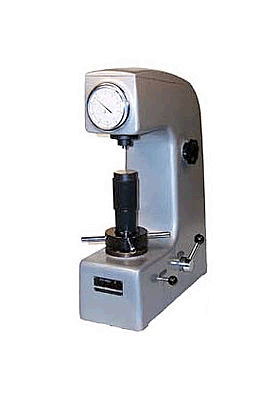Ox
Diamond
- Joined
- Aug 27, 2002
- Location
- Northwest Ohio
I need to try to check and maybe sort alum extrussions.
Taking what I could git my grubby's on post haste - I borrowed this Phase II unit that a chum got with sumptihng that he actually wanted at an auction.
Doesn't know how to run it. Didn't come with any manuals, or tooling kit.
item detail

I got it in early enough today that I was still able to decipher that I need the 1/16" ball tip, and got it ordered in time for tomorrows delivery. (MSC)
I have watched a few youtube vids, but none on this particular unit.
The ones that I see say that they have a hydraulic piston that from what I can see - doesn't allow it to "drop" so quickly.
But this thing doesn't appear to have such (and the price reflects that I s'pose). But if I just throw the lever, it comes down with a bang!
Now, I have found that with two handed manipulation, that I can hold the one lever while I throw the other, and then let it down easy, but it seems quite awkward for that to be how it was intended to be used.
I git the part about running the needle up to red dot and zeroing the dial to my intended scale. And currently I have a 120* tip in it, so it is going to China in my alum, but ... it is going past one full rev, and I'm guessing that should not be the case - right?
Can anyone help me with a quick step by step tutorial on this particular unit?
On a second and related subject:
I know that Rb is NOT where I need to be as Brinell would be better for my app, and likely anything that I would be using it for. (I don't doo inhouse H/T)
Not only that, but I really can't be seen with a "Phase II" unit in my shop. It's just "unbecomming" in my Made in USA (or at the very least - not made in China) shop. SO - while searching E-bay, I found this thing, and it is close by, but I am very ??? about it.
Brinell Hardness Tester 10″ DIAMETER 12″ VERTICAL TRAVEL OF TABLE FOOT PEDAL 5 W | eBay
I don't understand what the electrics is all about? Obviously this is from just over the hill from the "Digital" era....
I asked the seller for more pics and why the electrics, but he seems to have sidestepped those questions.
Would anyone know if this would be a decent machine for my app?
And what the electrics is all about? (Kind'a big guns for a task light eh?)
---------------------
Think Snow Eh!
Ox
Taking what I could git my grubby's on post haste - I borrowed this Phase II unit that a chum got with sumptihng that he actually wanted at an auction.
Doesn't know how to run it. Didn't come with any manuals, or tooling kit.
item detail

I got it in early enough today that I was still able to decipher that I need the 1/16" ball tip, and got it ordered in time for tomorrows delivery. (MSC)
I have watched a few youtube vids, but none on this particular unit.
The ones that I see say that they have a hydraulic piston that from what I can see - doesn't allow it to "drop" so quickly.
But this thing doesn't appear to have such (and the price reflects that I s'pose). But if I just throw the lever, it comes down with a bang!
Now, I have found that with two handed manipulation, that I can hold the one lever while I throw the other, and then let it down easy, but it seems quite awkward for that to be how it was intended to be used.
I git the part about running the needle up to red dot and zeroing the dial to my intended scale. And currently I have a 120* tip in it, so it is going to China in my alum, but ... it is going past one full rev, and I'm guessing that should not be the case - right?
Can anyone help me with a quick step by step tutorial on this particular unit?
On a second and related subject:
I know that Rb is NOT where I need to be as Brinell would be better for my app, and likely anything that I would be using it for. (I don't doo inhouse H/T)
Not only that, but I really can't be seen with a "Phase II" unit in my shop. It's just "unbecomming" in my Made in USA (or at the very least - not made in China) shop. SO - while searching E-bay, I found this thing, and it is close by, but I am very ??? about it.
Brinell Hardness Tester 10″ DIAMETER 12″ VERTICAL TRAVEL OF TABLE FOOT PEDAL 5 W | eBay
I don't understand what the electrics is all about? Obviously this is from just over the hill from the "Digital" era....
I asked the seller for more pics and why the electrics, but he seems to have sidestepped those questions.
Would anyone know if this would be a decent machine for my app?
And what the electrics is all about? (Kind'a big guns for a task light eh?)
---------------------
Think Snow Eh!
Ox


